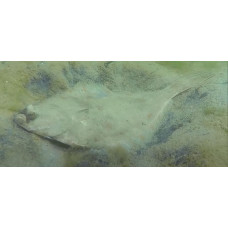Latin name
Platichthys flesus
Other names
Platichthys flesus, Flesus vulgaris
Identification
The body is flattened. Both eyes are on the same upper side of the body. In most fish, the eyes are on the right side. The pectoral fins are on either side of the body, one pointing up and the other down. The river flounder's best defence is its ability to change colour and adapt to its environment. Under normal conditions, the top of the flounder's body is brown with yellow, brown or black speckles. The underside of the body is white, less commonly white with brown spots. If necessary, the flounder will change colour and may take on the colour of sand or bottom mud, and may even be covered with spots, resembling pebbles. The colouration changes over several days so that the fish buries itself in the sand to camouflage itself better. When the flounder swims, its flat body moves up and down in a wave-like motion. The dorsal and ventral fins may also be involved in the movement.
Distribution
Occurs off the coasts of Scandinavia, Central Europe and the Mediterranean from the tidal limit to a depth of 55 m, as well as in estuaries and some coastal lakes. Occurs from the Arctic coast of northern Norway to the coast of North Africa. Can live in both salt and fresh water.
Habitat
It is a solitary fish, but on spawning grounds it gathers in large groups. The fish usually lies on its side in sand or mud, allowing water to pass through the gills on the top of its body.
Size
Maximum body length 60 cm, usually up to 50 cm. Body weight up to 2.9 kg.
Life history and Behavior
Adult fish often travel long distances to reach spawning grounds. They can lose up to 10% of their weight during this journey.
Food and feeding habits
It feeds on molluscs, crustaceans, worms and other animals. European Flounder have very strong teeth, which allows them to feed on animals with hard shells, such as cockles and crabs.
Reproduction
It reaches sexual maturity at 3-5 years of age. Fattens in fresh and brackish water, but breeds in the sea. Spawns at depths of 5-75 metres. Spawning season: February to May (depending on water temperature). Fecundity ranges from 200,000 to 2.5 million eggs, depending on the size of the female. The incubation period is about 30 days at 2°C. Eggs are pelagic, 0.8-1.3 mm in diameter. The larvae are pelagic and feed on small planktonic organisms. Larvae have eyes on either side of the head. Larvae have the same symmetrical body structure as other fish. When they reach 10 mm in length, they metamorphose and become benthic.
| Classification | |
| Phylum | Chordata |
| Class | Actinopterygii |
| Squad | Pleuronectiformes |
| Family | Pleuronectidae |
| Genus | Platichthys |
| Species | P. flesus |
| Features | |
| Conservation status | Least Concern |
| Habitat | Bottom |
| Life span, years | No information |
| Maximum body weight, kg | 2,9 |
| Maximum length, cm | 60 |
| Sailing speed, m/s | No information |
| Threat to people | Edible |
| Way of eating | Predator |
European Flounder
Tags: european flounder


